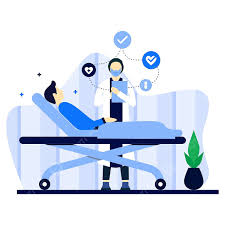Harm to a patient in the medical field can lead to the emergence of both tortious and contractual liability of medical professionals. Below are the main features of each type of responsibility.
- Tort liability.
Delinquent liability arises on the basis of general norms of civil law on the infliction of damage. Key aspects include.
Grounds for tort liability:
• Presence of damage.
• Illegal behavior of a medical worker.
• Causal connection between the illegal behavior and the damage caused.
• Fault of the medical professional (intention or negligence).
Features:
• Liability may arise regardless of the existence of a contractual relationship between the patient and the medical professional.
• Responsibility can be both personal (for individual medical workers) and collective (for medical institutions).
Types of damage:
• Material damage (costs of treatment, lost earnings, etc.).
• Moral damage (physical and moral suffering).
Contractual liability.
Contractual liability arises on the basis of the violation of the terms of the contract between the patient and the medical institution or medical worker. Key aspects include.
Grounds for contractual liability:
• Availability of a valid contract between the parties.
• Violation of the terms of this contract.
• Presence of damage caused by this violation.
• Causal connection between the breach of the terms of the contract and the damage caused.
Features:
• Liability arises only if there is a contract between the patient and the medical facility or employee.
• Liability is limited to the terms and conditions of the contract.
• May include provisions limiting liability or compensation (eg, liquidated damages, fines).
Types of damage:
• Damage provided by the terms of the contract (for example, reimbursement of the cost of non-provided or improperly provided medical services).• Other types of damage that may be stipulated by the contract (for example, moral damage, if it is expressly stated in the contract).
Interaction of tort and contractual liability.
There are situations where tort and contractual liability can overlap:
• The patient can simultaneously demand compensation for damages based on breach of contract and on the basis of general rules on the imposition of damages.
• Judicial practice in such cases may take into account both types of liability, depending on the specific circumstances of the case.
Legislative framework.
In Ukraine, the issues of responsibility of medical workers are regulated by the following legal acts:
• Civil Code of Ukraine - defines general provisions on tort and contractual liability.
• Law of Ukraine "Basics of Ukrainian legislation on health care" - regulates the provision of medical services and liability for violations in this area.
• The Criminal Code of Ukraine - provides for liability for crimes related to improper provision of medical services.
Evaluation. legal analysis of the situation / lawyer's consultation - Injuring a patient can lead to tortious or contractual liability of medical professionals, depending on the existence of a contractual relationship and the nature of the violation. Each case requires an individual approach to determine the appropriate type of liability and amount of compensation.
Compensation for material damage caused by mutilation or other health damage involves compensation for a number of costs and losses incurred by the victim. The main types of material damage subject to compensation include:
- 1. Treatment costs:
• Expenses for the purchase of medicines.
• Expenses for medical services (examinations, operations, procedures, hospitalization).
• Expenses for rehabilitation and restoration of health (physiotherapy, massages, spa treatment).
2. Care costs:
• Expenses for care services, if the victim needs permanent or temporary outside care.
• Costs of special care and assistive devices (crutches, wheelchairs, special beds, etc.).
3. Lost earnings (income):
• The amount of wages or other income that the victim did not receive due to the loss of working capacity (full or partial).
• Losses from lack of income during the period of temporary incapacity for work or reduced working capacity.
4. Professional reorientation costs:
• Expenses for learning a new profession or upgrading skills, if the victim lost the opportunity to continue working in his profession.
5. Other expenses:
• Transportation costs (transportation to medical institutions, treatment, etc.).
• Expenses for special meals, if medically necessary.
• Expenses for the purchase of special devices or equipment for the home, if necessary due to the victim's health.
Legal regulation.
In Ukraine, issues of compensation for material damage caused by mutilation or other health damage are regulated by the following basic legal acts:
• Civil Code of Ukraine (Articles 1195–1208) – defines general provisions on compensation for damage caused by mutilation or other health damage.
• Code of Labor Laws of Ukraine – regulates the issue of work-related disability and compensation payments.
• The Law of Ukraine "Basics of Ukrainian Legislation on Health Care" - provides for the rights of patients and the obligations of medical institutions regarding the provision of medical care and compensation for damage.
Verification of documents by a lawyer / lawyers' documents - Material damage caused by disability or other health damage includes a wide range of costs and losses related to treatment, care, loss of earnings and other aspects. Compensation for such damage must ensure the restoration of the victim's financial condition to the level that existed before the damage was inflicted.
In the event of a person's death as a result of illegal actions, compensation is subject to various types of material damage that may be caused to family members of the deceased and other persons who had the right to support him. Material damage subject to compensation includes:
- 1. Burial expenses.
• Expenses for the organization of the funeral (various funeral services, coffin, rent of a room for the ceremony, transport costs, etc.).
• Costs for purchasing a place in a cemetery or cremation.
• Expenses for the installation of a grave monument.
2. Lost earnings (income) of the deceased:
• The amount of wages or other income that the deceased could have received if he had remained alive and continued to work.
• Losses as a result of not receiving future income that the dependents of the deceased were counting on.
3. Assistance to persons entitled to maintenance:
• Amounts that the deceased would provide to his dependents (children, wife, parents, other family members or persons entitled to support).
• Monthly payments or benefits that dependents could have received from the deceased.
4. Other expenses:
• Expenses for the treatment and care of the deceased before his death, if incurred in connection with injuries or illnesses caused by wrongful acts.
• Expenses for psychological or other assistance for family members, if such expenses are directly related to the death of a loved one.
•
Legislative framework.
In Ukraine, the issue of compensation for material damage in the event of a person's death is regulated by the following basic legal acts:
• Civil Code of Ukraine (Article 1200) - determines the procedure and amount of compensation for damages in the event of the victim's death, including compensation for burial expenses and lost earnings.
• The Law of Ukraine "On Mandatory State Social Insurance" - provides for payments in connection with the loss of a breadwinner.
• The Criminal Code of Ukraine - contains provisions on criminal liability for acts that lead to the death of a person, and the procedure for compensating victims.
Legal opinion / legal opinion of a lawyer - Material damage caused in connection with the death of a person as a result of illegal actions includes a significant amount of expenses incurred by relatives and dependents of the deceased. Compensation for such damages is intended to provide financial support and compensation for losses that would have been covered by the deceased had he lived.

































